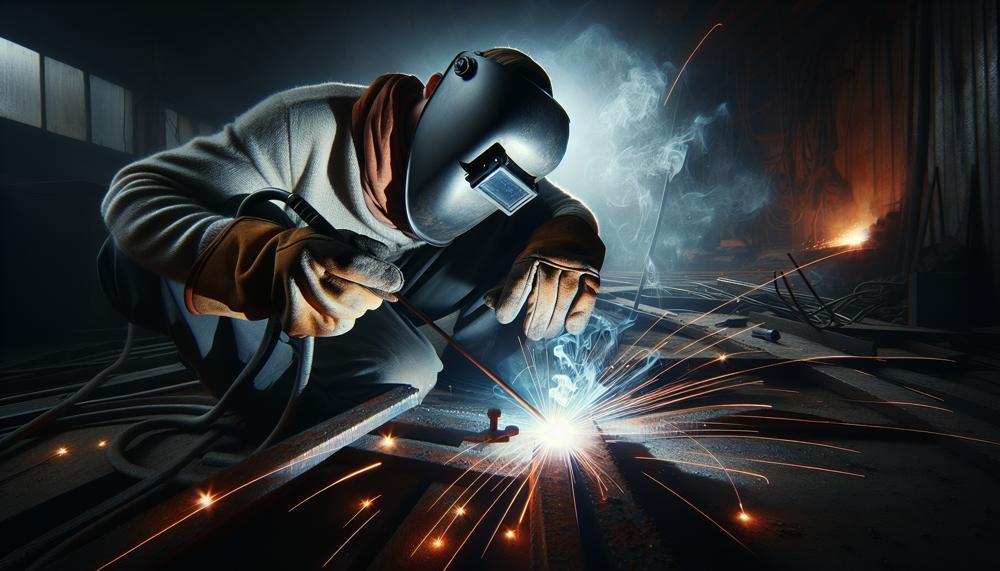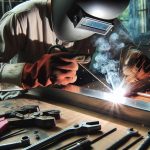Are you new to the world of stick welding and struggling to decide whether to push or pull while welding? Or are you an experienced welder looking to perfect your technique?
Stick welding, also known as shielded metal arc welding (SMAW), is a widely used method for joining metals together. While both techniques have their merits and drawbacks, it ultimately boils down to personal preference and the specific requirements of your project.
So get ready to don your helmet and join us as we explore the nuances of pushing and pulling in stick welding.
In this blog post, we will cover:
- The fundamentals of stick welding
- The distinctions between pushing and pulling while stick welding
- The pros and cons of each approach
- Tips for selecting the right technique for your project
Contents
- 1 What’s Difference Between Push And Pull In Welding?
- 2 You Should Pull The Puddle While Stick Welding
- 3 When to Push while Stick Welding
- 4 The Reality Of Pushing VS Pulling
- 5 The Proper Way To Stick Weld
- 6 Stick Welding Travel Angle
- 7 How To Strike An ARC
- 8 Can You Weld Sheet Metal With A Stick Welder?
- 9 Conclusion
What’s Difference Between Push And Pull In Welding?
When it comes to stick welding, there are two main techniques that are commonly used: pushing and pulling. While both methods have their own unique benefits and drawbacks, it is ultimately up to the welder to decide which technique works best for their specific needs.
Here’s a breakdown of the key differences between pushing and pulling in welding.
| The Pushing Technique | The Pulling Technique |
| Benefits: | Benefits: |
| – Offers better control and visibility of the weld puddle | – Provides greater penetration and potential for stronger welds |
| – Results in an aesthetically pleasing bead | – Ideal for thicker materials or tight spaces |
| – Easier for new welders to learn and control | |
| Drawbacks: | Drawbacks: |
| – Lower penetration compared to pulling technique | – Produces a thinner and less visually appealing bead |
| – Not suitable for joints that require high strength | – More difficult for new welders to control |
Other Factors That Influence the Decision to Push or Pull:
- Strength requirements of the joint, personal aesthetics preferences, joint location, and accessibility
Using Both Techniques Together:
In areas where both techniques can be used, a combination of pushing and pulling can result in a strong and visually appealing weld.
This is especially useful for welders who are looking to achieve the best of both worlds.
You Should Pull The Puddle While Stick Welding
To achieve superior control, penetration, and appearance, as well as prevent slag inclusions, mastering the technique of pulling the puddle while stick welding is crucial. Not only does this allow for more precise and consistent welds, but it also results in deeper penetration, a smooth and even bead, and reduces the risk of slag inclusions. As a welder, it is essential to perfect this technique in order to produce strong and long-lasting welds.
When it comes to welding, one must have a steady hand and a sharp eye. But with the added skill of pulling the puddle while stick welding, one can take their welding game to the next level. This technique essentially involves dragging the molten puddle of metal along the joint being welded, instead of pushing it. By doing so, welders can better control the size and shape of the weld pool, ensuring a more uniform and consistent result.
Not only does pulling the puddle while stick welding improve control and appearance, but it also allows for deeper penetration. This means that the weld will bond more strongly with the base metal, resulting in a stronger and more durable weld.
Additionally, this technique creates a smoother and more even bead, which not only looks better but also improves the structural integrity of the weld.
When to Push while Stick Welding
When it comes to stick welding, the decision of whether to push or pull can greatly impact the end result. There are various factors that should be considered before deciding which direction to go, such as the type of electrode being used, the thickness and condition of the base metal, and personal preference or technique.
- Type of electrode: The type of electrode being used is a crucial factor in determining whether to push or pull while stick welding. Certain electrodes, like cellulose-based ones, are designed to be pushed, while others, such as rutile-based ones, are meant to be pulled. It is important to refer to the manufacturer’s guidelines for the specific electrode to determine its recommended direction.
- Thickness and condition of base metal: For thicker base metals or those with surface imperfections like rust, pushing the electrode is generally preferred. This technique creates a stronger and more controlled weld, allowing for better penetration into the base metal.
- Personal preference/technique: Every welder has their own unique techniques and preferences when it comes to pushing or pulling while stick welding. It is important to experiment and find what works best for you and your specific welding situation.
In addition to these factors, it is also important to consider the direction of the arc and the angle at which the electrode is held. The general rule of thumb is to keep the arc directed towards the puddle.
If you are pushing the electrode, hold it at a slight angle towards the direction you are moving in. Conversely, if you are pulling, hold it at a slight angle away from the direction you are moving in.
The Reality Of Pushing VS Pulling
The reality of pushing vs pulling in stick welding is determined by the direction of the arc and electrode movement. Pushing creates a concave arc, while pulling produces a convex arc, influencing weld pool size, shape, and penetration, thus affecting the weld’s overall quality.
In addition, pushing and pulling have varying effects on spatter, visibility, and heat input. Pushing decreases spatter due to its concave arc, while pulling can generate more spatter due to its convex arc. Pulling also allows for better visibility of the weld pool, making it easier to control and maintain proper technique. Furthermore, pulling results in less heat input, which is beneficial for thinner base metals.
The type of electrode used also plays a significant role in the welding process. For example, pushing is typically preferred when using cellulose electrodes as it helps minimize spatter and porosity. On the other hand, pulling is commonly utilized with rutile electrodes as it offers better control and produces a smoother finish.
Moreover, the condition of the base metal can also influence whether to push or pull while stick welding. If the base metal is rusty or damaged, pushing may be more effective in creating a strong weld due to increased heat input. However, if the base metal is clean and in good condition, pulling may be preferred to ensure proper penetration.
Technique also plays a crucial role in determining whether to push or pull while stick welding. Some welders may find one method more comfortable or natural than the other, which can impact the overall quality of the weld as it affects their ability to maintain a consistent arc length and speed.
The Proper Way To Stick Weld
When it comes to stick welding, there is no one-size-fits-all approach. Whether you’re pushing or pulling, the best technique for you depends on the project at hand and your level of experience.
Both methods have their strengths and weaknesses, and it’s crucial to know when to use each one. Factors such as the joint position, type of electrode, and amount of amperage also play a role in determining whether to push or pull in stick welding.
However, the most important factor is practice and experimentation. Every welder is different, and what works for one may not work for another. That’s why it’s essential to try out different techniques and see what works best for you.
For novice welders, pushing is often the recommended approach as it requires less skill and effort compared to pulling. The pushing technique involves moving the electrode away from the weld pool, which can result in a smoother and more even weld.
On the other hand, pulling can be more challenging as it requires steady hand movements and precise control of the electrode angle. However, experienced welders may prefer pulling as it allows for better visibility of the weld pool, making it easier to control the weld’s quality.
When deciding between pushing or pulling in stick welding, factors such as joint position should also be taken into consideration. Pushing may be more suitable for flat or horizontal joints while pulling may be preferred for vertical or overhead joints.
Additionally, the type of electrode used can also affect which technique is more appropriate. Pushing is commonly used with cellulose-based electrodes, while pulling is often used with rutile-based electrodes.
Stick Welding Travel Angle
When it comes to stick welding, there are two techniques at play – pushing and pulling. These two methods involve moving the electrode in different directions. Pushing means moving the electrode away from the weld pool, while pulling involves moving it towards the weld pool. This difference in direction has a direct impact on the travel angle, which is the angle at which the electrode is held in relation to the workpiece.
To achieve a deep penetration, a steeper travel angle (around 20-30 degrees) is recommended when pushing, as it concentrates the heat on a smaller area. Conversely, for better coverage of the weld pool and a wider bead, a shallower travel angle (around 5-15 degrees) should be used when pulling.
The direction of electrode movement also affects the arc and penetration. Pushing creates a narrower and deeper penetration by focusing the arc on the leading edge of the weld pool – perfect for thicker metals and deeper welds. Pulling, on the other hand, results in a wider and shallower penetration as the arc is spread out on the trailing edge of the weld pool. This technique is better suited for thinner metals and wider weld beads.
So, both pushing and pulling techniques have their own advantages in stick welding and should be used accordingly based on the type of metal and desired outcome. The travel angle plays a crucial role in achieving a quality weld using either method and should be adjusted accordingly.
How To Strike An ARC
To achieve a solid and robust weld, it is essential to master the skill of striking an arc during stick welding. This crucial step involves creating an electric arc between the electrode and the workpiece, melting the consumable electrode, and forming the filler metal. To guide you in this process, here are the steps to follow when striking an arc during stick welding:
- Prepare your welding machine by setting the appropriate amperage and polarity for the specific type of metal you are working with.
- Position the electrode at a 75-90 degree angle from the workpiece, ensuring that the tip is approximately 1/8 inch away from the surface.
- With a swift motion, strike the arc by tapping or scratching the electrode against the workpiece while gently pulling it back.
- To prevent overheating or sticking, maintain a consistent arc length of around 1/8 inch.
- With practice, you can become comfortable with striking an arc as it requires precision and control.
By following these steps diligently, you can successfully strike an arc during stick welding and create sturdy and durable welds.
Nevertheless, to improve your skills and achieve mastery in stick welding, it is crucial to continue practicing and refining your technique.
Remember always to prioritize safety by wearing necessary protective gear and maintaining a safe work environment.
Can You Weld Sheet Metal With A Stick Welder?
The use of a stick welder for welding sheet metal comes with several limitations and challenges that one must consider. From burn throughs to controlling heat and slag formation, stick welding may not be the ideal choice when working with thin metals like sheet metal.
One of the primary limitations of using a stick welder for sheet metal is the high risk of burning through the metal. The intense heat produced by the welding process can quickly melt and burn through thinner metals, resulting in weak or damaged joints. Achieving clean welds can also be difficult, adding to the challenge.
Precise control of heat is crucial when using a stick welder, which can be challenging when working with sheet metal. The high heat levels can easily warp or distort the thin metal, making it difficult to maintain the desired shape and size.

Additionally, removing slag, a byproduct of stick welding, can be time-consuming and labor-intensive, especially on sheet metal where it tends to stick and is challenging to remove.
While there are many types of electrodes available for different metals and jobs, options specifically designed for welding sheet metal may be limited. This can make it challenging to find the right electrode for optimal results when working with sheet metal.
Furthermore, stick welding is not suitable for thin metals due to its high heat levels, limiting its use for delicate projects or repairs.
Also Read: Can Air Compressor Tanks Be Welded?
Conclusion
In the world of stick welding, the age-old question of whether to push or pull has sparked endless debates. As we’ve delved into in this article, both techniques have their own strengths and weaknesses. However, ultimately, the decision comes down to personal preference and the specific demands of your project.
Whether you’re a beginner welder or a seasoned pro looking to perfect your craft, having a solid understanding of stick welding fundamentals is crucial. From familiarizing yourself with the differences between pushing and pulling to considering factors like joint position and electrode type, there is no one-size-fits-all approach.
But one thing is certain – mastering both pushing and pulling techniques is vital for achieving top-notch welds that are not only strong but also visually appealing.





